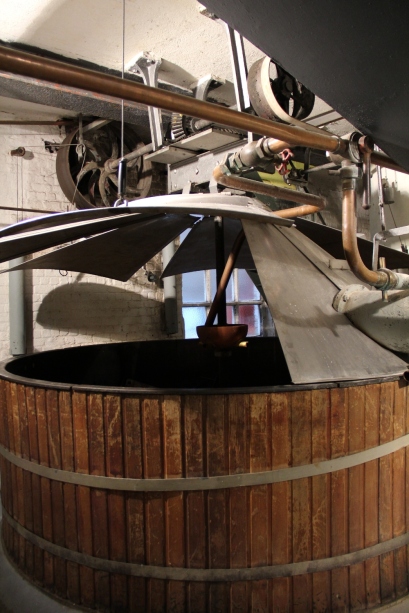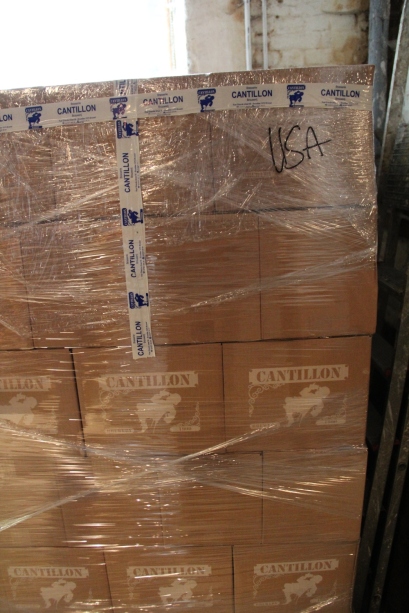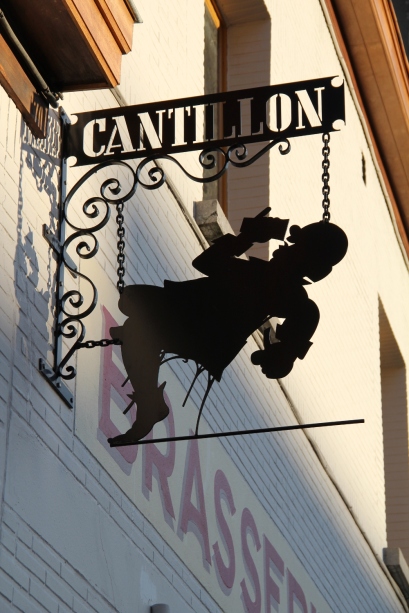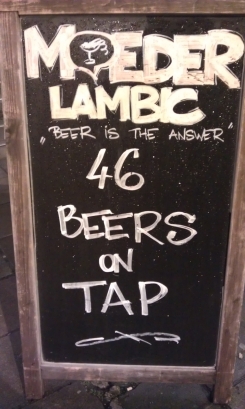Eureka, I have to mention first that this is a very scientific biochemistry, bioinformatics post about Brettanomyces. However, I hope those of you with less biology experience can follow as well or at least get the idea of the main messages. This post is mainly about an insight into the mitochondrial genome of two Brettanomyces species and comparing those sequences with Saccharomyces.
I always wondered how similar the genome sequence of a Saccharomyces cerevisiae and Dekkera/Brettanomyces yeasts are. To do such comparisons the DNA sequences have to be published first or at least sequenced. I am not yet through all the publications about the Brettanomyces genome sequencing and therefore don’t know yet if any complete genome of Brettanomyces/Dekkera is available at the moment. More about the yeast genomes in future posts.
I would like to start with a quick introduction about the whole topic to give those without a biology background a chance to understand the following points. This post is about comparing different DNA sequences from different yeasts. You might know that every living organism contains DNA which can be seen as the manual of the cell. The DNA encodes nearly everything the cell needs to work such as proteins, different RNAs etc. The whole DNA within a cell is commonly called genome. The DNA consists of four bases: Adenine, guanine, cytosine and thymine. In the DNA every information is encrypted with these four bases. The code to decipher the information from the four bases code into a protein is called the genetic code. If the genetic code is known you can encode a DNA sequence into proteins. Or vice versa. Before one can encode a DNA sequence the sequence has to be known. And this is the process called DNA sequencing. By DNA sequencing you determine the sequence of the four bases in the DNA. Knowing DNA sequences is very important for modern biology to for example understand certain diseases. On the other hand, DNA sequences are in general very specific for every living organism. This can be used to detect certain organisms. I hope this is enough information for the beginning.
One disadvantage of sequencing genomes of yeasts is their size. Sequencing big genomes is always challenging. Before modern techniques such as shotgun sequencing came widely available the only way of sequencing large genomes was really time-consuming and thus really expensive. This is different today and a lot of people around the world are working on sequencing projects. Me included.
To compare any genomic sequences or get any information about the evolutionary relationship of Saccharomyces and Brettanomyces, one has to look at the DNA of the two yeasts and compare them. And since I don’t know yet if the full genome sequence of at least one Dekkera/Brettanomyces strain is sequenced one has to look at a different DNA. And that’s where the mitochondrial genome comes into play. Mitochondria are the organelles in the cell responsible for several pathways such as supplying the cell with energy. And mitochondria have their own DNA, called mitochondrial DNA (mtDNA) because mitochondria originate from bacteria cells (see endosymbiotic theory). To summarize this theory, some time ago a cell incorporated a bacteria cell and the incorporated bacteria cell lived on within the first one and became the mitochondria. And since the mitochondria was a bacteria cell with DNA, the DNA still exists in some part within the mitochondria. The whole amount of this mtDNA is then called the mitochondrial genome. Because mtDNA are relatively short compared with the genomic DNA of a yeast, sequencing mtDNA is relatively easy. The first sequencing of a mtDNA sequence of D. bruxellensis and B. custersianus has been completed by E. Procházka et al in 2010 [Procházka et al, 2010]. All the data below is from this publication.
Since Saccharomyces cerevisia is an eukaryotic model organism for scientists, the whole genome of this yeast is already sequenced. Including the mtDNA. The mitochondrial genome sequence has been published and can be found here under the accession number AJ011856. For D. bruxellensis (strain CBS 2499) the sequence is deposited with the accession number NC_013147. And for the B. custerianus strain (CBS 4805) with the accession number GQ354525. If you look at one of the deposited genomes you can see the sequence at the bottom of the entry.
Lets begin with a look at the mtDNA of Saccharomyces cerevisiae. One can see that the mtDNA is circular and 85779 bp long (Fig 1). All the red arrows represent a specific gene encoded on the DNA. I only included the genes because with all the other annotated stuff such as tRNA etc the picture would simply be unreadable. One can observe that it seems that all the genes are facing in the same direction. This simply means that only one strand of the DNA is used for coding. (DNA is double stranded).

Fig 1: mtDNA Saccharomyces cerevisiae
Moving on to D. bruxellensis. Again a circular mtDNA (Fig 2). By the way, the publication mentioned above was the first to demonstrate that the mtDNA in Brettanomyces is circular. This mtDNA is 76453 bp long and includes a lot of genes as well. However, some genes face a different direction than others. The mitochondrial genome in D. bruxellensis therefore uses both strands as coding strands. This is already different compared to S. cerevisiae in Fig 1.

Fig 2: mtDNA D. bruxellensis
And at last a quick look at the mtDNA in B. custersianus (Fig 3). Yet again a circular mtDNA with a length of 30058 bp. This is much shorter than in S. cerevisiae and D. bruxellensis. And yet again, the genes are read on only one strand.

Fig 3: mtDNA B. custersianus
Lets briefly summarize the first few observations and lets compare them. All the mtDNA genomes are circular. The sizes in S. cerevisiae and D. bruxellensis are more or less the same. The mtDNA in B. custersianus though is significantly shorter than the other two yeasts. On the other hand the genes in both S. cerevisiae and B. custersianus are one single strand and genes in D. bruxellensis on both.
All these observations already tell me that these three yeasts are really not the same based on their mitochondrial genomic setup. One might argue about the size differences but the different gene orientation is quite remarkable in my opinion.
Moving on with further comparisons. Below is a table with the number of genes encoded in the mitochondrial genomes in all three yeasts and the number of tRNAs (transfer RNA). If you don’t know what tRNAs are just don’t bother. I will not get into any details about these tRNAs in this post.
|
S. cerevisiae |
D. bruxellensis |
B. custersianus
|
| Genes (including tRNA) |
42 |
46 |
47 |
| tRNA |
24 |
25 |
25 |
| Genes (without tRNA) |
18 |
21 |
22 |
By just looking at the number of genes one might already tell that there seems to be a difference in the number of genes without tRNAs between S. cerevisiae and Brettanomyces/Dekkera. All the mitochondria seem to have roughly the same number of tRNAs. I will not get into further detail about the tRNAs here. If you need further information please have a look at the original publication. I would like to talk about the differences in genes instead.
Lets have a closer look at some of the genes encoded in the mitochondrial DNA in the three yeasts. Please keep in mind that over 99% of the proteins present in the mitochondria originate from the cytosol: Newly synthesized cytosolic proteins are transported from the cytosol across the outer membrane by the TOM40:TOM70 complex. Thus the mitochondria DNA does not have to encode for a lot of proteins as it can easily be seen by looking at the table above.
The following genes are encoded within the mtDNA:
- Cytochrome oxidase subunits 1, 2, 3 (cox1, cox2, cox2)
- Apocytochrome b (cob)
- ATP-synthase subunits 6, 8, 9 (atp6, atp8, atp9)
- Mitochondrial small and large rRNAs (rns, rnl)
- RNAse P (rnpB)
- Mitochondrial subunit ribosomal protein 3 (rps3)
A lot of these proteins can be found in S. cerevisiae as well. But this does not mean the DNA sequences are the same though. More about that later on. Indeed there are some genes only encoded in the two Brettanomyces/Dekkera mtDNAs:
- NADH dehydrogenase subunits 1, 2, 3, 4, 4L, 5, 6 (nad1-4, nad4L, nad5-6)
This is an enzyme complex (also known as respiratory chain complex I) and catalyzes the reaction of NADH to NAD+.
The next question to answer is if the genes found in both yeast species have the same sequences or not. I would like to look at one set of genes.
Cytochrome c oxidase:
The cytochrome c oxidase complex consists of three different subunits, subunit 1 to 3. Cytochrome c oxidase catalyzes the reduction of oxygen to water and plays a very important part in the respiratory chain. Below is a table showing the length [bp] of the different genes.
| |
S. cerevisiae |
D. bruxellensis |
B. custersianus |
| COX1: cytochrome c oxidase subunit 1 |
12884* |
5348* |
5436* |
| COX2: cytochrome c oxidase subunit 2 |
756 |
738 |
744 |
| COX3: cytochrome c oxidase subunit 3 |
810 |
810 |
810 |
Both yeasts have the three subunits encoded in their mitochondrial DNA. However, in D. bruxellensis subunit 1 has 3 exons, 4 exons in B. custersianus, and 8 exons in case of S. cerevisiae. The CDS (coding sequence) in D. bruxellensis and B. custersianus are 1629 bp and 1605 bp long in S. cerevisiae.
Comparing the two protein sequences of the Brettanomyces/Dekkera strains shows a pairwise identity of 85.1% (MAFFT alignment). For the other two subunits 2 and 3 in the two strains 88.8% for COX2, 81.9% for COX3.
Comparing COX1 from D. bruxellensis with S. cerevisiae shows a pairwise identity of 70.3%. COX1 from B. custersianus and S. cerevisiae are 70.5% identical.
Comparing COX2 from D. bruxellensis with S. cerevisiae shows a pairwise identity of 75.8% (Fig 4). COX2 from B. custersianus and S. cerevisiae are 73.9% identical.
Comparing COX3 from D. bruxellensis with S. cerevisiae shows a pairwise identity of 70.4%. COX3 from B. custersianus and S. cerevisiae are 70.1% identical.

Fig 4: Comparing COX2 from D. bruxellensis with S. cerevisiae shows a pairwise identity of 75.8%
This is a very nice example that all the three yeasts have the same protein function (cytochrome c oxidase) but the sequences are not the same and not even encoded the same way (different exons) or direction (as shown above). On the other hand not even the two Brettanomyces/Dekkera strains have the same sequences. Still the sequences are more identical in the two Brettanomyces/Dekkera strains than compared to S. cerevisiae.
Putting this all together, the three different yeast strains look very different at a molecular level (different size, using two strands as coding strands). The genes don’t even have the same exact sequences. In the end all the yeasts produce proteins with the same function. This is quite remarkable in my opinion. Another big difference between S. cerevisiae and Dekkera/Brettanomyces is the existence of the NADH dehydrogenase in the latter yeasts.
I hope this post was not too complicated and got you some ideas about the different genetic setup of Saccharomyces and Brettanomyces/Dekkera. In the end all the yeasts achieve the same but all with a different setup. This is simply remarkable and in my opinion a brilliant example how evolution impacts an organism. Not to say that even within the same species such as Brettanomyces/Dekkera two different strains (D. bruxellensis and B. custersianus) might have very different setups as well. This makes me wonder what a look at the genomic DNA might reveal…
I would like to end by mentioning that this is a nice example to show people what one can do by just looking at DNA sequences and why it is important in my opinion to sequence organisms in the first place. Such insights are not possible if no DNA sequences are available. Don’t expect the genomic Brettanomyces DNA insight soon. This will take me much longer to prepare because there is much more data to process…
Bibliography
- E. Procházka, S. Poláková, J. Piskur and P. Sulo, 2010. Mitochondrial genome from the facultative yeast Dekkera bruxellensis contains the NADH dehydrogenase subunit gene. FEMS Yeast Res, 10, 545-557 (Pubmed)








 Cool, right? We even have some pretty neat labels such as the black one shown below for the special releases
Cool, right? We even have some pretty neat labels such as the black one shown below for the special releases and a white version for the occasional releases. I am very proud that we came up with the label design on our own…
and a white version for the occasional releases. I am very proud that we came up with the label design on our own… Before we head into the marathon to finally have the license to sell beer, we first work on our basic recipes to have some nice basic recipes. The next steps would be to tweak them and implement some unique twists. As we do not want to invest in a bigger brewing equipment (yet?) and just sell really small amounts (lets say 50% of a batch), we do not have to brew the same recipe over and over again. We and a lot of our present consumers (they drink our beers in the brewery) like the diversity. We will still brew the stuff we like. Not what others like. In the end, we do not want to earn a lot of money with or brewery. Just enough to brew further more exciting batches. Maybe going professional is an option in the future? We will see.
Before we head into the marathon to finally have the license to sell beer, we first work on our basic recipes to have some nice basic recipes. The next steps would be to tweak them and implement some unique twists. As we do not want to invest in a bigger brewing equipment (yet?) and just sell really small amounts (lets say 50% of a batch), we do not have to brew the same recipe over and over again. We and a lot of our present consumers (they drink our beers in the brewery) like the diversity. We will still brew the stuff we like. Not what others like. In the end, we do not want to earn a lot of money with or brewery. Just enough to brew further more exciting batches. Maybe going professional is an option in the future? We will see.






 In the picture above is a small part of the fermenters. On the very left side with the beautiful pellicle is the
In the picture above is a small part of the fermenters. On the very left side with the beautiful pellicle is the  Then right next to the Flanders fermenters are the
Then right next to the Flanders fermenters are the 
 Well, this is the end so far. I hope you know have a clearer idea what our equipment looks like and what experiments are currently running. Hope you enjoyed reading this long post and stay tuned!
Well, this is the end so far. I hope you know have a clearer idea what our equipment looks like and what experiments are currently running. Hope you enjoyed reading this long post and stay tuned!























